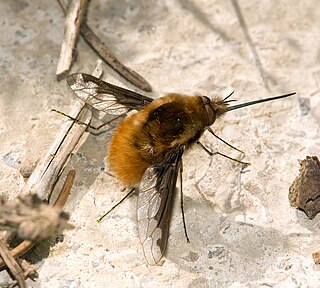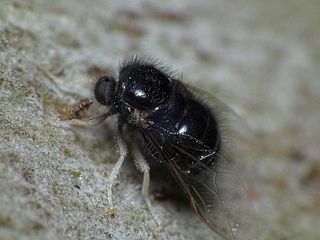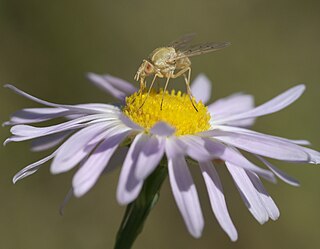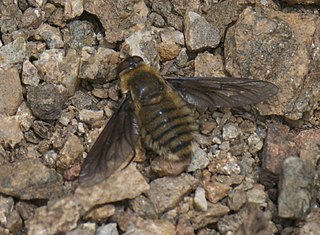
The Bombyliidae are a family of flies, commonly known as bee flies. Some are colloquially known as bomber flies. Adults generally feed on nectar and pollen, some being important pollinators. Larvae are mostly parasitoids of other insects.

The Asiloidea comprise a very large superfamily insects in the order Diptera, the true flies. It has a cosmopolitan distribution, occurring worldwide. It includes the family Bombyliidae, the bee flies, which are parasitoids, and the Asilidae, the robber flies, which are predators of other insects.

The Acroceridae are a small family of odd-looking flies. They have a hump-backed appearance with a strikingly small head, generally with a long proboscis for accessing nectar. They are rare and not widely known. The most frequently applied common names are small-headed flies or hunch-back flies. Many are bee or wasp mimics. Because they are parasitoids of spiders, they also are sometimes known as spider flies.

Bombylius major is a parasitic bee mimic fly. B. major is the most common type of fly within the Bombylius genus. The fly derives its name from its close resemblance to bumblebees and is often mistaken for them.
Uramya pristis is a species of fly in the family Tachinidae. It is a parasitoid of Limacodidae moths, and overwinters in its pupal stage.
Systropus arizonicus is a species of bee fly in the family Bombyliidae. It is found in Mexico and Arizona.

Systropus is a genus of bee flies in the family Bombyliidae. There are over 200 described species in the genus Systropus, found on every continent except Antarctica.

Toxophorinae is a subfamily of bee flies in the family Bombyliidae. There are five living genera and two extinct genera containing more than 400 described species in Toxophorinae.
Bombylius albicapillus is a species of bee fly in the family Bombyliidae. It occurs in western North America.
Poecilognathus punctipennis is a species of bee fly in the family Bombyliidae. It is found in Florida and Georgia.

Poecilognathus is a North and South American genus of bee flies in the family Bombyliidae. There are about 13 described species in Poecilognathus.
Exoprosopa parda is a species of bee fly in the family Bombyliidae.

Poecilanthrax monticola is a species of bee fly in the family Bombyliidae. It is found in North America, from British Columbia and Alberta south to Nebraska, Utah, and Colorado.

Thevenetimyia luctifera is a species of bee fly in the family Bombyliidae. It is found in western North America from Mexico north to British Columbia, Canada, and as far east as Colorado in the United States.

Thevenetimyia speciosa is a species of bee fly in the family Bombyliidae. It is known from Arizona.

Lepidanthrax is a genus of bee flies in the family Bombyliidae. There are at least 50 described species in Lepidanthrax. The genus is primarily North and Central American, but one species is recorded from the Galapagos Islands and two are recorded from Australia.
Systropus bicornis is a species of bee fly in the family Bombyliidae. It is found in Mexico.
Systropus angulatus is a species of bee fly in the family Bombyliidae. It is found in Texas.

Dipalta serpentina is a species of bee fly in the family Bombyliidae. It is widespread in North America from British Columbia, Canada south and east through most of the United States to Florida, Mexico, Cuba, Guatemala, and Honduras. It is a parasitoid of antlion species such as Myrmeleon immaculatus.
Uramya halisidotae is a species of fly in the family Tachinidae. It is a parasitoid of Lophocampa argentata.










